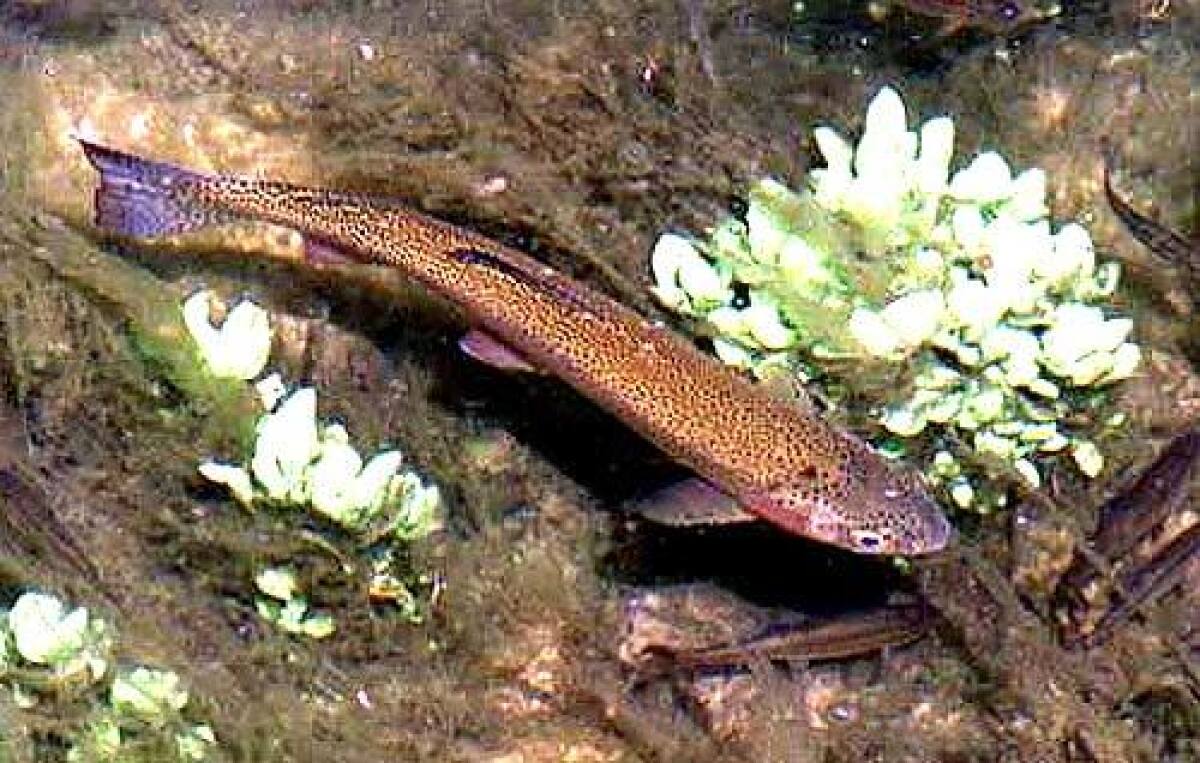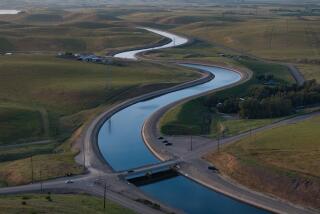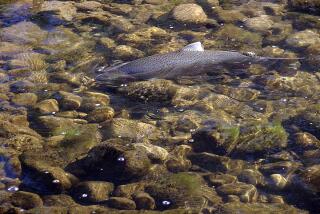‘Kool-Aid fish’

When this year’s record rainfall deluged Southern California, some anglers worried that the big water might be a body blow to the few remaining steelhead. Once plentiful in local rivers and streams, Southern steelhead, a seagoing rainbow trout, have been protected by the Endangered Species Act for eight years.
But as the water subsides, biologists are confirming that these fish can survive nature’s harshest extremes. They say the drenching actually improved what little natural habitat is left to them, although they warned that the fish are under new threats from disease and invasive species.
According to Mark Capelli, a National Marine Fisheries Service biologist who’s developing a recovery plan for the southern steelhead, the surging runoff — from one of Southern California’s wettest winters on record — rejuvenated spawning grounds by dislodging sediment and clearing plant-choked streams.
Capelli’s findings are based on a week spent backpacking the middle section of Piru Creek and visiting the Ventura and Santa Clara rivers looking for steelhead during and after the runoff. At Sespe Creek, he found young fish emerging from the gravel and beginning to feed and grow.
“You saw the same thing everywhere,” Capelli says. “Pools scoured out, fine sediments flushed from the system, gravel rearranged, in-stream choking vegetation removed and a lot of evidence of spawning activity.”
And that’s exactly what he and other scientists were hoping to see.
Craig Fusaro, a marine biologist and board member of the wild fish advocacy group, CalTrout, photographed a spawning pair of steelhead on Mission Creek in downtown Santa Barbara in March.
Other biologists recently donned snorkels and masks to look for steelhead in the Ventura River above the new $8-million Robles fish ladder. They were surprised at the number of fish they saw.
Like salmon, steelhead are anadromous, meaning they spend their early years in coastal freshwater river systems, then grow big in the ocean’s food-rich environment before returning to their natal streams to reproduce. Members of a subspecies of rainbow trout, steelhead get their name from a metallic-colored burnish they acquire during the time they spend in saltwater. Steelhead are prized by anglers because of their size and strength; think trout on steroids.
Before World War II, steelhead were counted in the tens of thousands in Southern California rivers. Hollywood lore has it that in the 1930s, film production halted whenever fish runs of as many as 50,000 adult steelhead lured stars such as Spencer Tracy and Clark Gable to the banks of the Santa Clara and Ventura rivers. Flood control and water storage projects, however, cut off access to steelhead spawning grounds and the steelhead population in Southern California nearly disappeared, Fusaro says.
Not much was done to save the fish until 1997, when southern steelhead, considered genetically distinct from their more numerous northern cousins, were listed as endangered after prodding by CalTrout.
“Blocking off access to headwaters is why steelhead have declined to near extinction,” says Jim Edmondson, south coast manager for CalTrout. Unlike northern fish, Southern steelhead may not always return to their natal streams. Biologists think this is an adaptation to Southern California’s erratic weather and has allowed the species to reproduce in alternate locations if water in their home stream dries up.
Loss of habitat isn’t the only threat that steelhead face, however. Capelli is worried that New Zealand mud snails, which have infected some Eastern Sierra rivers, could spread to coastal streams where steelhead thrive. The snails, which have no natural predators in the U.S., are spread by wading anglers and can crowd out native invertebrates that trout feed on.
Whirling disease is another threat to the fish. This winter, a batch of trout from a private Idaho hatchery that was used to stock Lake Casitas and other local lakes tested positive for the parasite that attacks the skeletal and nervous systems of young trout and salmon. The disease is named because the affected fish swim in circles (it is not harmful to humans). In Montana the disease has led to a decline in the trout population, wiping out 90% of newly spawned wild trout in some rivers.
If Lake Casitas overflows, as it has in the past, Capelli fears the planted fish could spread the disease to steelhead in the Ventura River.
“If young steelhead become infected, they are easy prey for other fish,” says Bill Cox, a California Department of Fish and Game fish pathologist who discovered the diseased fish. “Populations that are hanging on the brink of extinction don’t need another thing that makes it easy for them to die.”
Despite the threats to this fragile population, Capelli is optimistic about the steelhead’s chances of recovery — so long as the fish are one day given a chance to return to their historic spawning ground. Steelhead are short-lived, quick growing and produce thousands of eggs at a time.
Fusaro shares that optimism and admiration for the steelhead’s resilience. “These are Kool-Aid fish,” he says. “Just add water, and they appear.”






